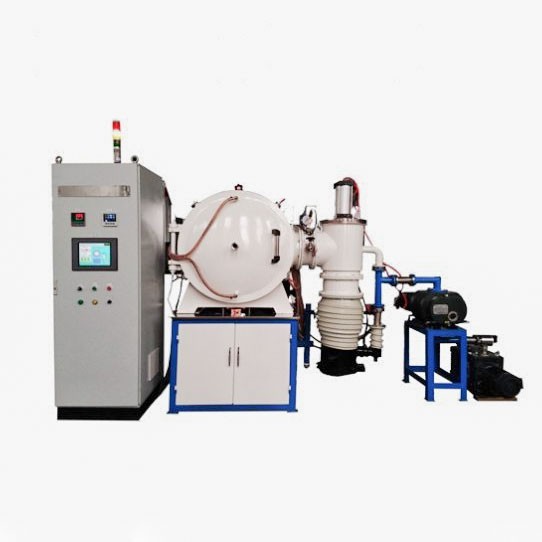
Vacuum Furnace
2200 ℃ Graphite Vacuum Heat Treat Furnace
Item Number : KT-VG
Price varies based on specs and customizations
- Max. temperature
- 2200 ℃
- Max. Vacuum Level
- 6*10^-3Pa
- Temperature control accuracy
- ±1℃

Shipping:
Contact us to get shipping details Enjoy On-time Dispatch Guarantee.
Why Choose Us
Reliable PartnerEasy ordering process, quality products, and dedicated support for your business success.
Discover the 2200℃ Graphite Vacuum Furnace
The KINTEK 2200℃ Graphite Vacuum Furnace is engineered for demanding high-temperature processes in vacuum or controlled atmospheres. Utilizing graphite felt for thermal insulation and robust graphite resistant rods as heating elements, this furnace achieves a maximum working temperature of 2200℃, making it an indispensable tool for advanced material research and production.
Key Features & Benefits
- Extreme Temperature Capability: Reaches up to 2200℃, ideal for sintering tungsten alloy, silicon carbide, molybdenum alloy, titanium alloy, cemented carbide, and carbon materials.
- Superior Vacuum Performance: Achieves a high vacuum level up to 6*10-3Pa with no high-temperature gassing, ensuring process purity.
- Excellent Vacuum Integrity: Maintains a stable vacuum environment with a low pressure rise rate of 0.67Pa/h, critical for consistent results.
- Efficient Cooling System: Features a vacuum shell body with a double-layer water-cooling jacket for rapid cooling and a lower outer shell surface temperature, enhancing safety and operational comfort.
- Precise Temperature Control: Equipped with a PID programmable microprocessor system for accurate temperature management (±1℃), optimizing process outcomes.
- Durable Heating Elements: Professionally configured graphite heating elements are optimized for heat radiation and extended service life.
- Controlled Atmosphere Ready: Independent air input and output ports allow for operation under various protective or reactive atmospheres.
- Flexible Vacuum Control: Optional manual and automatic pneumatic vacuum valves cater to diverse operational requirements and automation levels.
- Comprehensive Safety Systems:
- Overcurrent protection and over-temperature alarm with automatic power-off.
- Built-in thermocouple detection with automatic heating stoppage and alarm upon breakage or failure.
- Safety interlock system powers off the furnace if the door is opened, or in cases of over-temperature or sensor failure.
- Power failure restarting function to resume heating programs post-interruption.
Technical Specifications
| Furnace model | KT-VG | ||
| Max. temperature | 2200 ℃ | ||
| Constant work temperature | 2100 ℃ | ||
| Chamber insulation material | Graphite felt | ||
| Heating element | Graphite resistant rod | ||
| Heating rate | 0-10℃/min | ||
| Temperature sensor | T/R thermocouple and infrared thermometer | ||
| Temperature controller | Touch screen PID controller with PLC | ||
| Temperature control accuracy | ±1℃ | ||
| Max. Vacuum Level | 6*10-3Pa (No-load, cold state) | ||
| Vacuum Pressure Rise Rate | 0.67Pa/h | ||
| Electric power supply | AC110-440V,50/60HZ (Customizable) | ||
| Standard Chamber Sizes (Customizable) | |||
| Chamber size (mm) (WxDxH or Dia.xH) | Effective volume (L) | Chamber size (mm) (WxDxH or Dia.xH) | Effective volume (L) |
| 200x200x300 | 12 | 400x400x600 | 96 |
| 300x300x400 | 36 | 500x500x700 | 150 |
| KINTEK welcomes custom design requirements for chamber size and volume. | |||
Chamber Design Options
Our graphite vacuum furnaces are available with versatile chamber configurations to suit your specific process needs, including vertical and horizontal orientations.
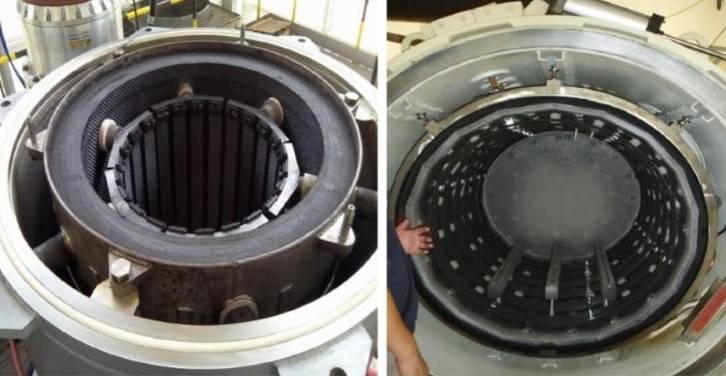

Wide Range of Applications
The KT-VG Graphite Vacuum Furnace is extensively used across various industries for critical high-temperature material treatments in vacuum or protective atmospheres. Key applications include:
- Vacuum reaction sintering of materials like tungsten alloy, silicon carbide, molybdenum alloy, titanium alloy, cemented carbide, and carbon materials.
- High-temperature brazing and soldering.
- Annealing and comprehensive heat treatment of metals and alloys.
- Debinding and sintering of advanced ceramic materials.
- Crystal growth processes.
- Vacuum coating and deposition techniques.
- Pioneering research and development of new materials.
Operating Principle
The 2200℃ Graphite Vacuum Furnace employs a high-temperature graphite heating element housed within an insulated graphite chamber. This specialized design ensures precise temperature control and uniform heat distribution. Operations are conducted under vacuum conditions, facilitating controlled atmosphere processing of materials at elevated temperatures. The vacuum environment is crucial for minimizing gas contamination, oxidation, and degassing, thereby preserving the purity and integrity of the treated materials.
Optional Customizations & Setup
Tailor the furnace to your exact needs with our range of optional features:
- Independent furnace temperature monitoring and recording systems.
- RS 485 communication port for PC remote control and seamless data exporting.
- Optional pneumatic vacuum valve linkage integrated with the temperature controller for automated processes.
- Advanced touch screen temperature controller with versatile, operator-friendly functions.
- Dedicated cold water circulation cooling machine for the furnace shell jacket cooling system.
Your Partner for Advanced High-Temperature Solutions
At KINTEK, we leverage exceptional R&D capabilities and in-house manufacturing to provide diverse laboratories and industries with cutting-edge high-temperature furnace solutions. While this page details our 2200℃ Graphite Vacuum Furnace, our full product line includes Muffle Furnaces, Tube Furnaces, Rotary Furnaces, other Vacuum & Atmosphere Furnaces, and specialized CVD/PECVD/MPCVD Systems.
Our core strength lies in deep customization. We are committed to understanding your unique experimental requirements and engineering a furnace that precisely meets your needs. Whether you require modifications to standard models or a completely bespoke design, our team is ready to collaborate with you.
Ready to discuss your high-temperature application or need a custom furnace solution? We're here to help. Please reach out to us by filling out our Contact Form, and one of our specialists will get back to you shortly.
FAQ
What Are The Main Applications Of A Vacuum Furnace?
What Is The Principle Of A Hot Press Furnace?
What Is An Atmosphere Furnace Used For?
What Is A Vacuum Induction Furnace?
What Are The Key Features Of A Vacuum Furnace?
What Are The Applications Of A Hot Press Furnace?
What Are The Key Features Of An Atmosphere Furnace?
What Are The Main Applications Of Vacuum Induction Furnaces?
How Does A Vacuum Furnace Work?
What Are The Features Of A Hot Press Furnace?
How Does An Atmosphere Furnace Work?
How Does A Vacuum Induction Furnace Work?
What Are The Advantages Of Using A Vacuum Furnace?
Why Is A Vacuum Environment Used In Hot Press Furnaces?
What Are The Advantages Of Using An Atmosphere Furnace?
What Are The Advantages Of Using A Vacuum Induction Furnace?
What Types Of Materials Can Be Processed In A Vacuum Furnace?
What Materials Are Commonly Processed In Hot Press Furnaces?
What Types Of Gases Can Be Used In An Atmosphere Furnace?
What Types Of Vacuum Induction Furnaces Are Available?
What Is The Difference Between Hot Wall And Cold Wall Vacuum Furnaces?
What Safety Features Are Available In Advanced Atmosphere Furnaces?
Why Is Temperature Control Important In Vacuum Induction Furnaces?
Can Vacuum Furnaces Be Customized For Specific Applications?
What Materials Can Be Processed In A Vacuum Induction Furnace?
How Does The Vacuum Environment Benefit Material Processing?
4.9
out of
5
Incredible precision and durability! This furnace exceeded all expectations.
4.8
out of
5
Fast delivery and top-notch quality. Worth every penny!
4.7
out of
5
The technological advancement in this furnace is mind-blowing. Highly recommend!
4.9
out of
5
Perfect for high-temperature applications. Built to last!
4.8
out of
5
Superb performance and excellent value for money. A game-changer!
4.9
out of
5
The vacuum seal is flawless. No complaints at all!
4.7
out of
5
Efficient and reliable. Delivered faster than expected!
4.8
out of
5
This furnace is a beast! Handles extreme heat with ease.
4.9
out of
5
The graphite construction is brilliant. No wear and tear even after heavy use.
4.7
out of
5
Impressive tech and solid build. A must-have for labs!
4.8
out of
5
Consistent performance and great customer support. Love it!
4.9
out of
5
The temperature control is spot-on. Perfect for precision work.
4.7
out of
5
Durable and efficient. Delivered in perfect condition.
4.8
out of
5
High-quality materials and superb craftsmanship. Very satisfied!
4.9
out of
5
The furnace heats up quickly and maintains temperature flawlessly.
4.7
out of
5
Great investment for any serious lab. Works like a charm!
4.8
out of
5
Reliable and high-performing. Exactly as described!
4.9
out of
5
The best furnace I've ever used. Zero defects and superb efficiency.
REQUEST A QUOTE
Our professional team will reply to you within one business day. Please feel free to contact us!
Related Products

Molybdenum Vacuum Heat Treat Furnace
High-performance molybdenum vacuum furnace for precise 1400°C heat treatment. Ideal for sintering, brazing, and crystal growth. Durable, efficient, and customizable.

600T Vacuum Induction Hot Press Vacuum Heat Treat and Sintering Furnace
600T Vacuum Induction Hot Press Furnace for precise sintering. Advanced 600T pressure, 2200°C heating, vacuum/atmosphere control. Ideal for research & production.
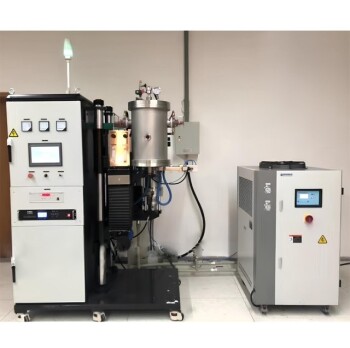
Vacuum Heat Treat Sintering Furnace Molybdenum Wire Vacuum Sintering Furnace
KINTEK's Vacuum Molybdenum Wire Sintering Furnace excels in high-temperature, high-vacuum processes for sintering, annealing, and material research. Achieve precise 1700°C heating with uniform results. Custom solutions available.

Small Vacuum Heat Treat and Tungsten Wire Sintering Furnace
Compact vacuum tungsten wire sintering furnace for labs. Precise, mobile design with superior vacuum integrity. Ideal for advanced material research. Contact us!

9MPa Air Pressure Vacuum Heat Treat and Sintering Furnace
Achieve superior ceramic densification with KINTEK's advanced air pressure sintering furnace. High-pressure up to 9MPa, precise 2200℃ control.

Vacuum Heat Treat Sintering and Brazing Furnace
KINTEK Vacuum Brazing Furnaces deliver precision, clean joints with superior temperature control. Customizable for diverse metals, ideal for aerospace, medical, and thermal applications. Get a quote!

Vacuum Heat Treat Furnace with Ceramic Fiber Liner
KINTEK's Vacuum Furnace with Ceramic Fiber Lining offers precise high-temperature processing up to 1700°C, ensuring uniform heat distribution and energy efficiency. Ideal for labs and production.

2200 ℃ Tungsten Vacuum Heat Treat and Sintering Furnace
2200°C Tungsten Vacuum Furnace for high-temperature materials processing. Precise control, superior vacuum, customizable solutions. Ideal for research & industrial applications.

Vacuum Hot Press Furnace Machine Heated Vacuum Press Tube Furnace
Discover KINTEK's advanced Vacuum Tube Hot Press Furnace for precise high-temperature sintering, hot pressing, and material bonding. Customizable solutions for labs.

Vacuum Induction Melting Furnace and Arc Melting Furnace
Explore KINTEK's Vacuum Induction Melting Furnace for high-purity metal processing up to 2000℃. Customizable solutions for aerospace, alloys, and more. Contact us today!

Vacuum Heat Treat Sintering Furnace with Pressure for Vacuum Sintering
KINTEK's Vacuum Pressure Sintering Furnace offers 2100℃ precision for ceramics, metals, and composites. Customizable, high-performance, and contamination-free. Get a quote now!

Laboratory Quartz Tube Furnace RTP Heating Tubular Furnace
KINTEK's RTP Rapid Heating Tube Furnace delivers precise temperature control, rapid heating up to 100°C/sec, and versatile atmosphere options for advanced lab applications.
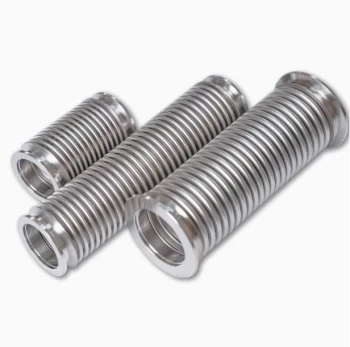
High Performance Vacuum Bellows for Efficient Connection and Stable Vacuum in Systems
KF ultra-high vacuum observation window with high borosilicate glass for clear viewing in demanding 10^-9 Torr environments. Durable 304 stainless steel flange.

1800℃ High Temperature Muffle Oven Furnace for Laboratory
KINTEK Muffle Furnaces: Precision 1800°C heating for labs. Energy-efficient, customizable, with PID control. Ideal for sintering, annealing, and research.

1400℃ Muffle Oven Furnace for Laboratory
KT-14M Muffle Furnace: Precision 1400°C heating with SiC elements, PID control, and energy-efficient design. Ideal for labs.

Spark Plasma Sintering SPS Furnace
Discover KINTEK's advanced Spark Plasma Sintering (SPS) Furnace for rapid, precise material processing. Customizable solutions for research and production.
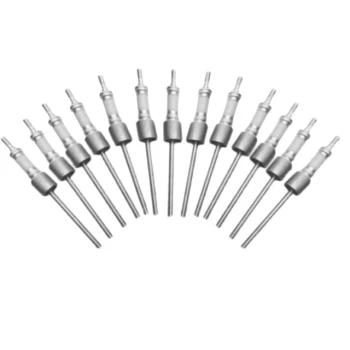
Ultra Vacuum Electrode Feedthrough Connector Flange Power Lead for High Precision Applications
Ultra-Vacuum Electrode Feedthroughs for reliable UHV connections. High-sealing, customizable flange options, ideal for semiconductor & space applications.

CF KF Flange Vacuum Electrode Feedthrough Lead Sealing Assembly for Vacuum Systems
Reliable CF/KF flange vacuum electrode feedthrough for high-performance vacuum systems. Ensures superior sealing, conductivity & durability. Customizable options available.
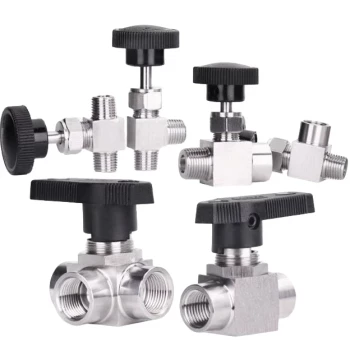
304 316 Stainless Steel High Vacuum Ball Stop Valve for Vacuum Systems
KINTEK's 304/316 stainless steel vacuum ball valves and stop valves ensure high-performance sealing for industrial and scientific applications. Explore durable, corrosion-resistant solutions.